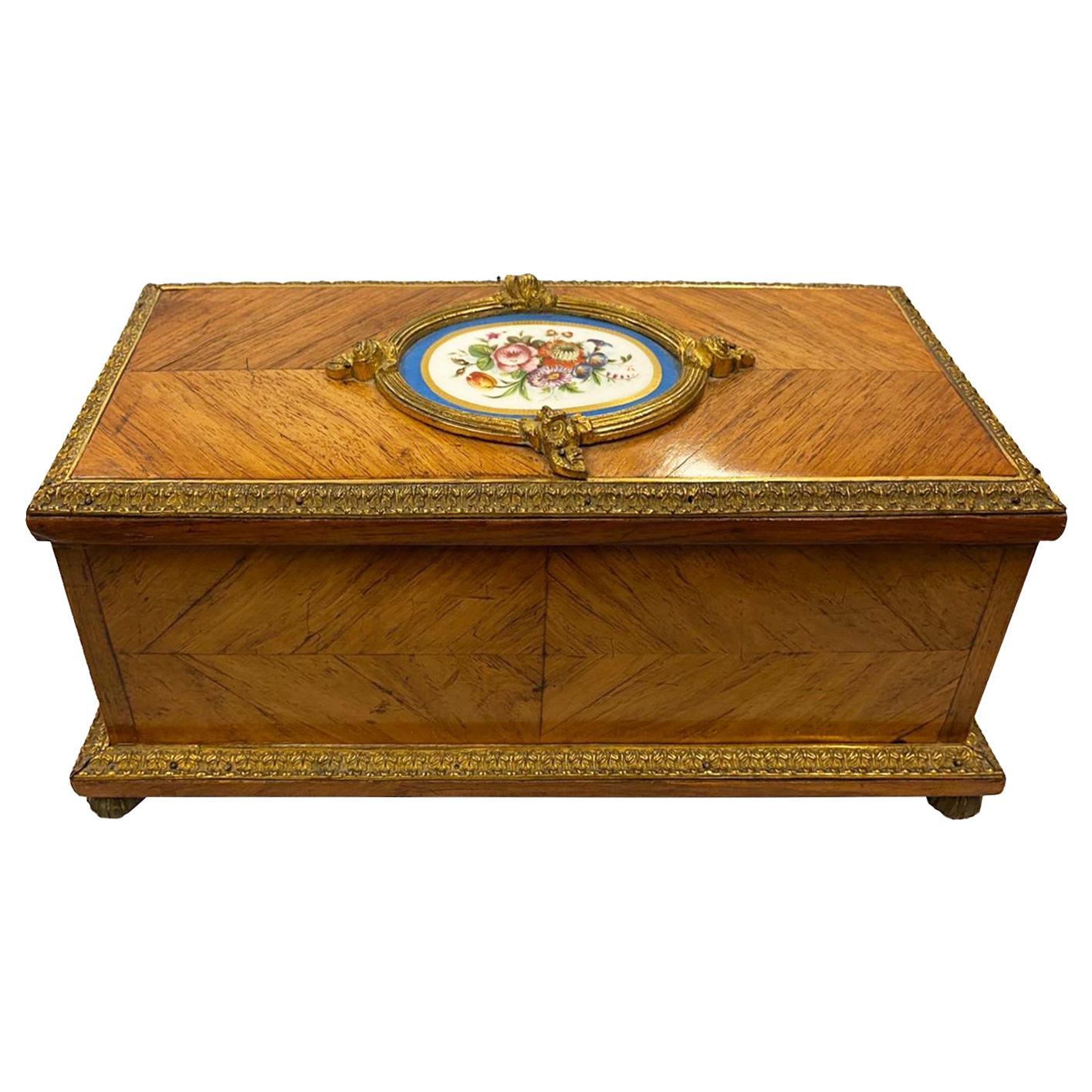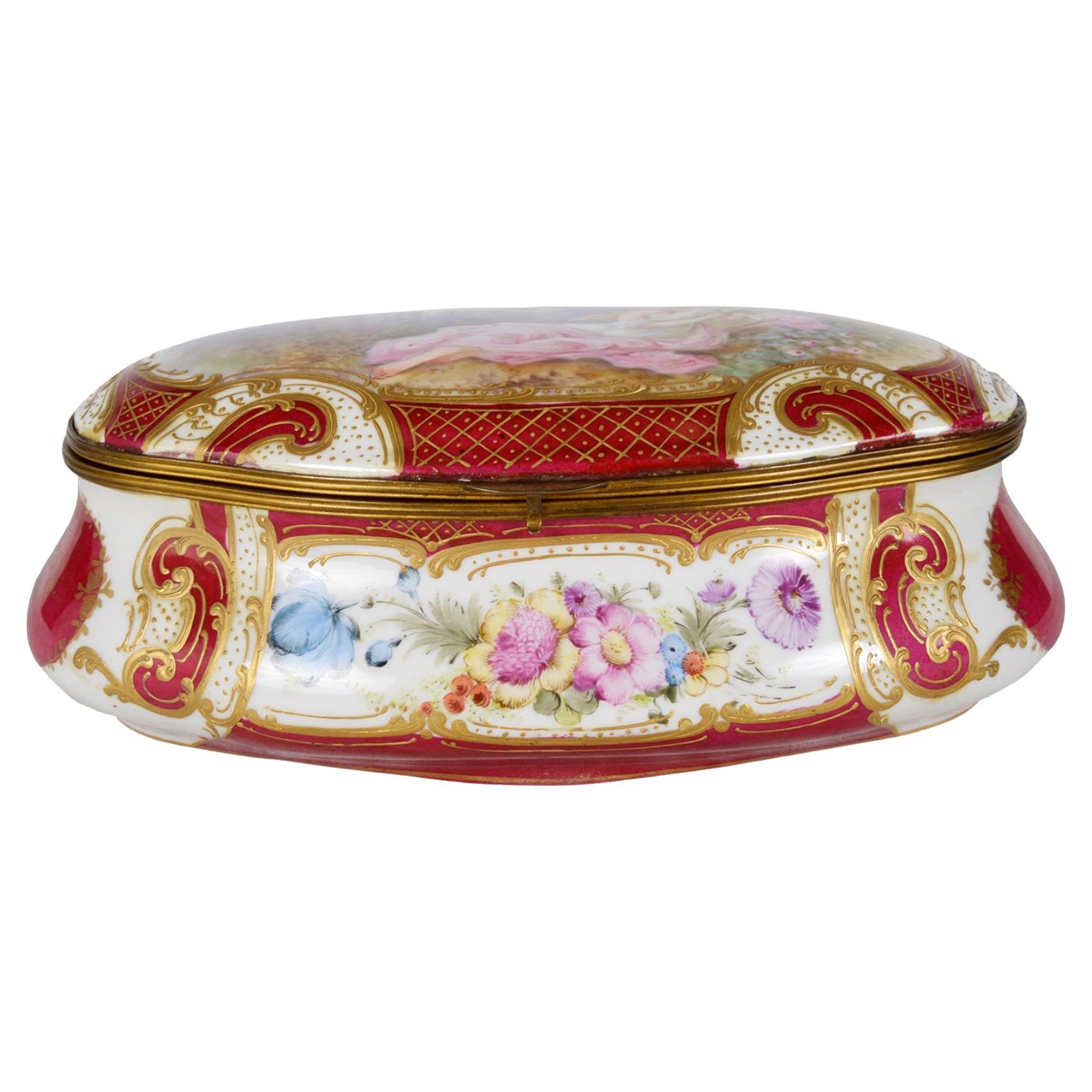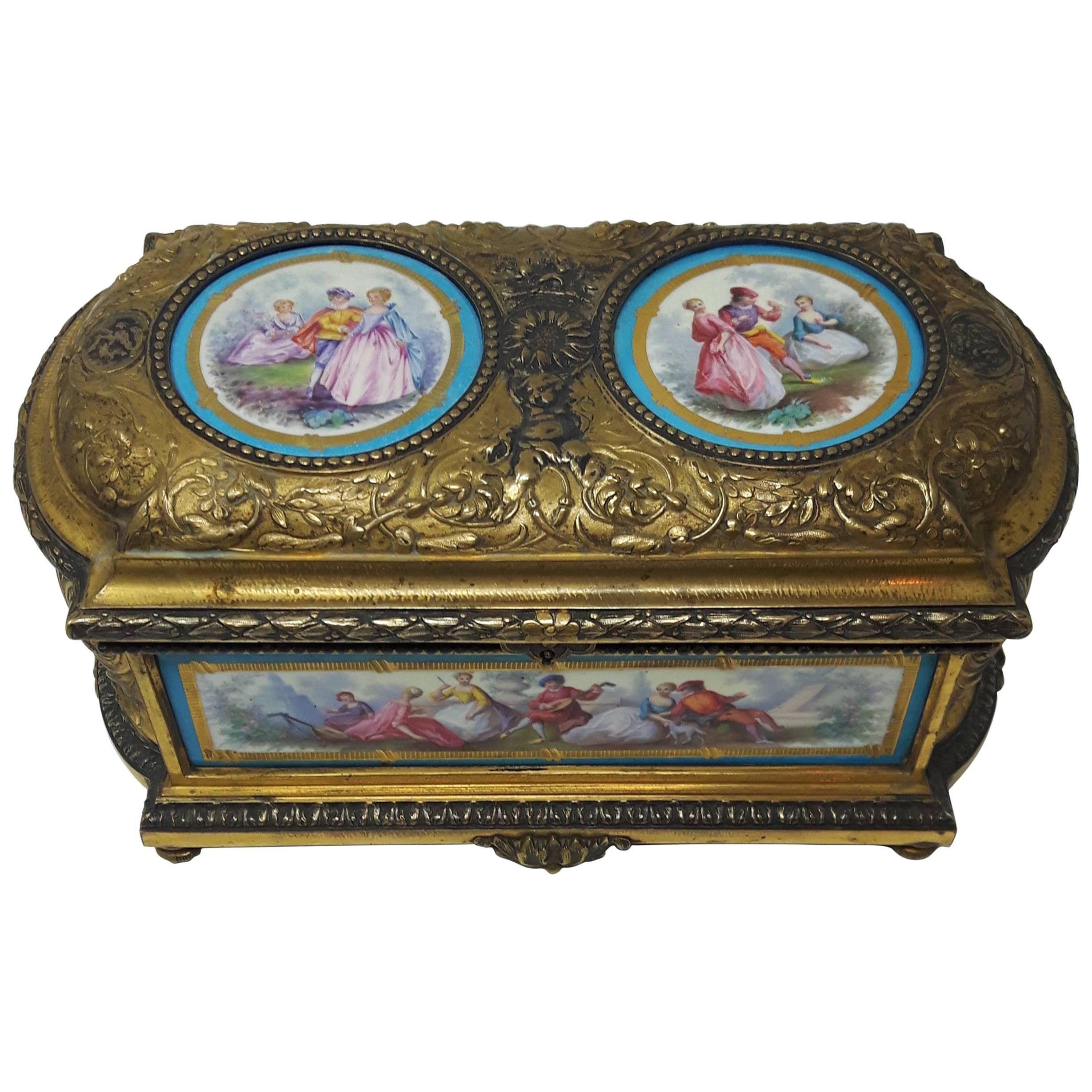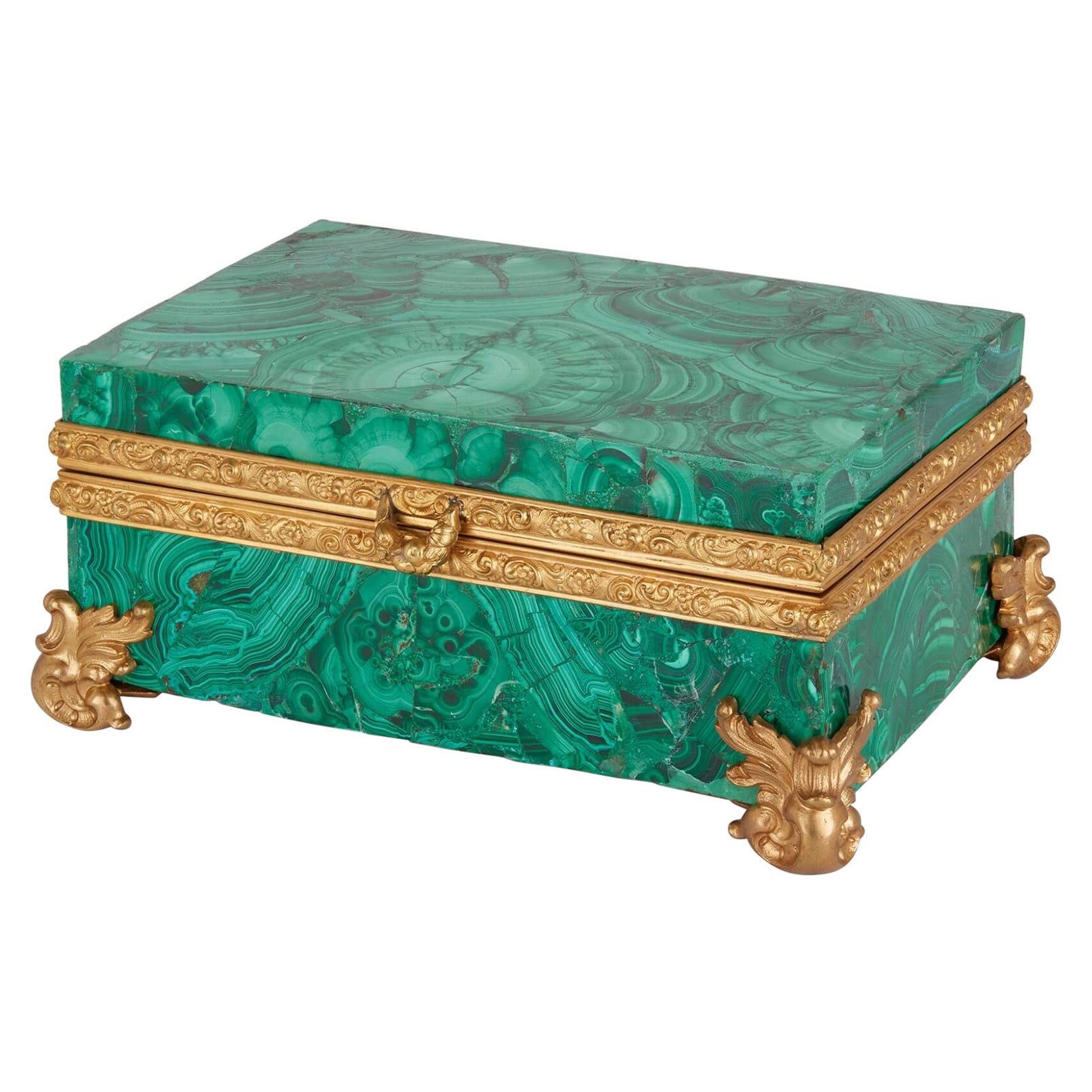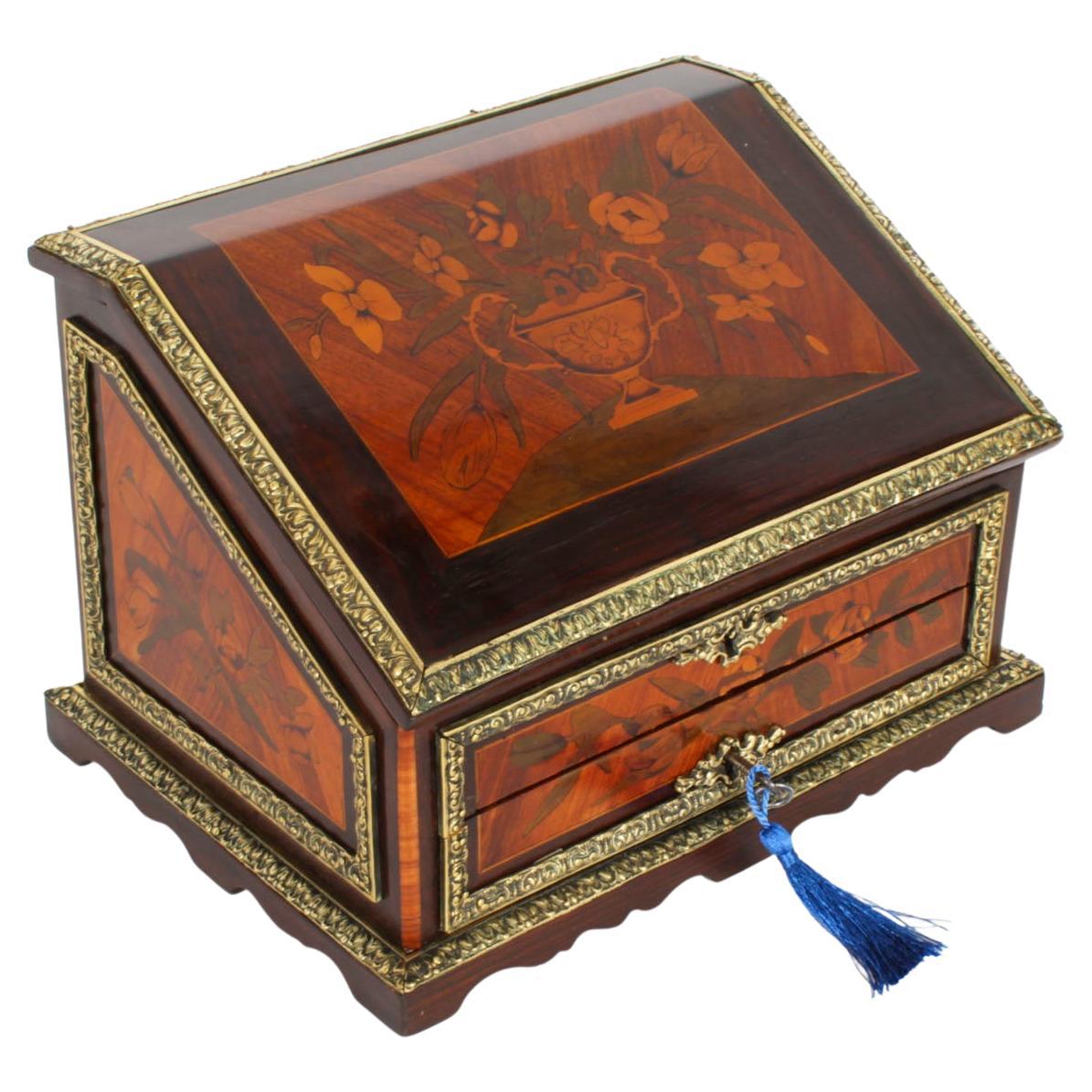Items Similar to Antique French Sevres Porcelain and Ormolu Jewellery Casket 19th Century
Want more images or videos?
Request additional images or videos from the seller
1 of 19
Antique French Sevres Porcelain and Ormolu Jewellery Casket 19th Century
About the Item
This is a fabulous antique French Ormolu and Sevres Porcelain jewellery casket, circa 1860 in date.
This magnificent casket is rectangular in shape with the top and each side exceptionally well decorated with superb ormolu mounts in the form of acanthus leaf corner straps, beading and ribbon twirls with foliate cresting which frame fabullous hand painted Sevres porcelain panels.
The panels feature splendid scenes of classically dressed children playing in landscapes, enclosed within charming gilt borders against a Bleu Celeste background.
The lid opens to reveal the sumptuous original peach velvet lined interior, which is ready to keep custody of your precious items.
It is raised on four magnificent gilt ball feet, which add an extra touch of opulence to this gorgeous piece.
Condition:
In excellent condition. With no chips, cracks or signs of repair, please see photos for confirmation.
Dimensions in cm:
Height 12 cm x Width 22 cm x Depth 14 cm
Dimensions in inches:
Height 5 inches x Width 9 inches x Depth 5 inches
Sevres Porcelain
traces its roots in France to early craftsmen who had small manufacturing operations in such places as Lille, Rouen. St. Cloud, and most notably Chantilly. It is from Chantilly that a cadre of workers migrated to the Chateau de Vincennes near Paris to form a larger porcelain manufactory in 1738.
French King Louis XV, perhaps inspired by his rumoured relationship with mistress Madame de Pompadour, took an intense interest in porcelain and moved the operation in 1756 to even larger quarters in the Paris suburb of Sevres. Sevres was also conveniently near the home of Madame de Pompadour and the King's own Palace at Versailles.
From the outset the king's clear aim was to produce Sevres Porcelain that surpassed the established Saxony works of Meissen and Dresden. Though the French lacked an ample supply of kaolin, a required ingredient for hard-paste porcelain (pate dure), their soft-paste porcelain (pate tendre) was fired at a lower temperature and was thus compatible with a wider variety of colours and glazes that in many cases were also richer and more vivid. Unglazed white Sevres Porcelain "biscuit" figurines were also a great success. However, soft-paste Sevres Porcelain was more easily broken. Therefore, early pieces of Sevres Porcelain that remain intact have become rare indeed.
The Sevres Porcelain manufactory always seemed to be in dire financial straits despite the incredibly fine works it produced. In fact, the king's insistence that only the finest items be created may have contributed to the difficulties. Only a limited number of European nobility could afford the extravagant prices demanded for such works. King Louis XV and eventually his heir, the ill-fated Louis XVI, were obliged to invest heavily in the enterprise. Ultimately, the Sevres Porcelain Factory produced items under the name of "Royal" and thus the well-known Sevres mark was born. King Louis XV even mandated laws that severely restricted other porcelain production in France so as to retain a near monopoly for his Sevres Porcelain. The king even willingly became chief salesman for the finest of his products, hosting an annual New Year's Day showing for French nobility in his private quarters at Versailles. He eagerly circulated among potential buyers, pitching the merits of ownership and policing the occasional light-fingered guest.
Sevres Porcelain may have indeed given the makers of Meissen and Dresden a run for their money by the end of the 18th Century but for the French Revolution. By 1800, the Sevres Porcelain Works were practically out of business due to the economic devastation of the new French Republic.
About the time when Napoleon Bonaparte named himself Emperor of France (1804), a new director was named for the Sevres Porcelain Manufactory. Alexandre Brongniart, highly educated in many fields, resurrected Sevres Porcelain. Soft-paste porcelain was eliminated altogether thanks to the earlier discovery of kaolin near Limoges. For four decades until his death, Brongniart presided over monumental progress for Sevres Porcelain, catering not only to Napoleon himself, but at last to include the more financially profitable mid-priced market in the emerging middle class.
Ormolu - (from French 'or moulu', signifying ground or pounded gold) is an 18th-century English term for applying finely ground, high-carat gold in a mercury amalgam to an object of bronze.The mercury is driven off in a kiln leaving behind a gold-coloured veneer known as 'gilt bronze'.
The manufacture of true ormolu employs a process known as mercury-gilding or fire-gilding, in which a solution of nitrate of mercury is applied to a piece of copper, brass, or bronze, followed by the application of an amalgam of gold and mercury. The item was then exposed to extreme heat until the mercury burned off and the gold remained, adhered to the metal object.
After around 1830 because legislation had outlawed the use of mercury other techniques were used instead. Electroplating is the most common modern technique. Ormolu techniques are essentially the same as those used on silver, to produce silver-gilt..
Our reference: A1249a
- Dimensions:Height: 4.73 in (12 cm)Width: 8.67 in (22 cm)Depth: 5.52 in (14 cm)
- Materials and Techniques:
- Period:
- Date of Manufacture:circa 1860
- Condition:
- Seller Location:London, GB
- Reference Number:
About the Seller
5.0
Platinum Seller
These expertly vetted sellers are 1stDibs' most experienced sellers and are rated highest by our customers.
Established in 1983
1stDibs seller since 2012
1,199 sales on 1stDibs
Typical response time: 1 hour
Associations
LAPADA - The Association of Arts & Antiques Dealers
- ShippingRetrieving quote...Ships From: London, United Kingdom
- Return PolicyA return for this item may be initiated within 14 days of delivery.
More From This SellerView All
- Antique French Marquetry and Ormolu Stationary Casket . 19th CenturyLocated in London, GBThis is a wonderful antique French Gonçalo Alves marquetry and ormolu mounted casket, circa 1860 in date. The casket of bureau form has a lift up top and is inlaid with a marquetry ...Category
Antique 1860s Decorative Boxes
MaterialsOrmolu
- Antique French Sevres Porcelain and Ormolu Jewelry Casket, 19th CenturyLocated in London, GBThis is a fabulous antique French Ormolu and Sevres Porcelain jewelry casket, circa 1870 in date. This magnificent casket is rectangular in shape, with the top as well as each sid...Category
Antique 1870s French Porcelain
MaterialsOrmolu
- Antique French Silvered Copper Jewellery Casket Box B Wicker 19th CLocated in London, GBThis is a beautiful Antique silvered copper French Jewellery Casket, engraved by by the famous French engraver B.Wicker, Paris C 1880's. This...Category
Antique 1880s French Jewelry Boxes
MaterialsCopper
- Antique French Silvered & Gilt Jewellery Casket Box AB Paris 19th CLocated in London, GBThis is a beautiful Antique silvered and gilt on copper French jewellery casket, signed AB Paris and Circa 1880 in date. Of rectangular form this wonderful casket is of very high quality and features the lid and sides decorated with relief cast scenic panels...Category
Antique 1880s French Jewelry Boxes
MaterialsCopper
- Antique Ormolu & Agate Mounted Casket by Asprey, 19th CenturyLocated in London, GBThis is a superb antique gilt bronze and agate mounted casket by Asprey, Circa 1870 in date. The casket features a rectangular outline with domed lid which opens to reveal two clear glass scent bottles. It is stamped Charles Asprey, 166 Bond Street, Provenance: Lady Elizabeth Prinfle Lady in waiting to Queen Victoria, lived at Bonchurch, Isle of Wight It is a lovely piece which will make an unforgettable gift. Condition: In excellent condition having been beautifully cleaned in our workshops, please see photos for confirmation. Dimensions in cm: height 10.5 x width 12.5 x depth 7.5 Dimensions in inches: height 4 inches x width 5 inches x depth 3 inches Asprey was established in England in 1781 and founded as a silk printing business by William Asprey, it soon became a luxury emporium. In 1841, William Asprey's elder son Charles went into partnership with a stationer located on London's Bond Street. In 1847 the family broke with this partner and moved into 167 New Bond Street, the premises Asprey occupies today. From its central London location Asprey advertised 'articles of exclusive design and high quality, whether for personal adornment or personal accompaniment and to endow with richness and beauty the table and homes of people of refinement and discernment.' An early speciality was dressing cases. Asprey crafted traditional cases and designs, mostly in leather, suitable for the new style of travel ushered in by railways. The main competitors at the time were H.J. Cave & Sons. Asprey was recognised for its expertise when it won a gold medal for its dressing cases at the International Exhibition of 1862 but lost out to its rivals, H.J. Cave & Sons in 1867. The company consolidated its position through acquisitions. In 1859 Asprey absorbed Edwards, an award winning maker of dressing cases and holder of a Royal Warrant. The company also purchased the Alfred Club at 22 Albemarle Street, which backed on to the New Bond Street store and meant that Asprey now had entrances on two of London's most fashionable streets. In 1862, Asprey was granted a Royal Warrant by Queen Victoria. The Prince of Wales, later to be crowned Edward VII, granted another Royal Warrant. In 1953, for the coronation of Elizabeth II, Asprey paid homage with the Asprey Coronation Year Gold Collection, which featured a dessert, coffee and liqueur service in 18-carat gold and weighed almost 27 pounds. In April 1953, it went on show in the New Bond Street store and subsequently toured the United States. As the business grew, the company acquired manufacturing facilities and hired silversmiths, goldsmiths, jewellers and watchmakers including Ernest Betjeman, the father of the distinguished poet John Betjeman, one of the most highly regarded craftsman and designers of his day. In the twenties, commissions poured in from around the world, from American millionaire J. Pierpont Morgan to potentates such as the Maharaja of Patiala, who commissioned a huge teak travelling trunk for each of his wives in which each trunk was fitted with solid silver washing and bathing utensils with waterspouts of ornate tiger head and lined with blue velvet. Asprey cigarette cases became collectable amongst young sophisticates who delighted in its other modern products, including travel clocks, safety razors and automatic pencil sharpeners. Asprey Jewellery Asprey has a tradition of producing jewellery inspired by the blooms found in English gardens. Over the decades jewelled interpretations of flowers have evolved to include the Crown Daisy, Rose, Calla Lily and Lily Pad collections. The master diamond cutter Gabi Tolkowsky created the Asprey cut. The cushion cut gave Tolkowsky options for incorporating the Asprey "A" inscription around the edges of the stone. The result was the 61-facet Asprey cut, maximising light refraction to brilliant effect. The shape of the Asprey cut means that the cutting process can be done only by hand, unlike many other stones that involve machine cutting. Asprey Leather - the women's collection of clutches and handbags, such as those featured in the 1781 collection, come from crocodile, python and ostrich. The men's collection includes wallets, cardholders and travel watch cases crafted from lido, calf or alligator. Other items include the briefcases and backgammon boards. Asprey Silver - offers classic and whimsical contemporary silver pieces – such as the saltcellar fashioned to look like a cement mixer...Category
Antique 1870s English Decorative Boxes
MaterialsAgate, Ormolu
- Antique Victorian Sterling Silver Jewellery Box Casket H. Matthews 19th CLocated in London, GBThis is a lovely antique Victorian sterling silver jewellery casket / pin cushion bearing the makers mark of H.Matthews, and hallmarks for Birmingham 1899. The hinged lid is fitt...Category
Antique 1890s English Victorian Jewelry Boxes
MaterialsSterling Silver
You May Also Like
- 19th Century French onyx + ormolu jewellery casket.Located in Brighton, SussexA very good quality French 19th Century onyx, ormolu mounted jewellery casket, having Pietra dura floral plaques to each corner, set into classically shaped gilded ormolu mounts. Ba...Category
Antique Late 19th Century French Jewelry Boxes
MaterialsOnyx, Ormolu
- French 19th Century 'Sevres' Porcelain Mounted CasketBy Tahan ParisLocated in Brighton, SussexA fine quality late 19th century gilded ormolu and Sevres style porcelain mounted casket, the hinged lid opening to a silk lined interior (needing repair) and raised on ormolu melon ...Category
Antique Late 19th Century French Louis XVI Decorative Boxes
MaterialsPorcelain, Walnut
- Late 19th Century French Sevres Style Porcelain CasketBy Manufacture Nationale de SèvresLocated in Brighton, SussexA very decorative late 19th century French Sevres style porcelain, hand painted casket. Having a Burgundy colour ground, with an inset pa...Category
Antique Late 19th Century French Louis XVI Decorative Boxes
MaterialsPorcelain
- 19th Century Sevres CasketBy Manufacture Nationale de SèvresLocated in London, GBA rare antique French gilt bronze and silver Sevres porcelain casket finely painted with neoclassical figures on two round and two rectangular ...Category
Antique Late 19th Century French Decorative Boxes
MaterialsCeramic
- Antique 19th Century Malachite and Ormolu CasketLocated in London, GBAntique 19th century malachite and ormolu casket Russian, Mid-19th Century Height 9cm, width 21cm, depth 15cm This magnificent malachite casket celebrates the work of 19th century ...Category
Antique Mid-19th Century Russian Decorative Boxes
MaterialsMalachite, Ormolu
- 19th Century Sevres Style CasketLocated in London, GB19th century French Sevres style ormolu and porcelain casket having light blue ground, painted with panels of romantic scenes.Category
Antique Mid-19th Century French Napoleon III Decorative Boxes
MaterialsOrmolu

